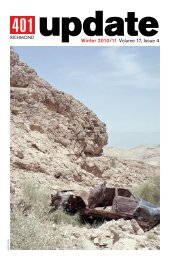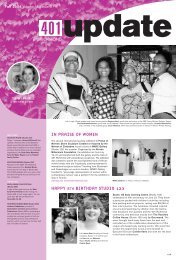Decmber 98/January 99 issue - 401 Richmond
Decmber 98/January 99 issue - 401 Richmond
Decmber 98/January 99 issue - 401 Richmond
Create successful ePaper yourself
Turn your PDF publications into a flip-book with our unique Google optimized e-Paper software.
Here is the second installment of Michael Cochrane’s (Studio 219)excellent article on inspirational workplaces. Reprinted here withpermission from “Workplace News” (September 19<strong>98</strong>).Village in a box?Workplace of the future(Part 2)By Michael G. CochraneIn my last column, I described the veryunusual and creative environment intowhich I have moved my mediation andconsulting practice in downtown Toronto.My loft office is in an old warehouse whichhas been overhauled by some enterprisingarchitects.It seems as much thought has gone intothe culture of the building, as into its actualinterior design, and it is this that has gotme thinking about where we choose towork. In my previous column, I describedthe building as a kind of “village in a box.”What does that mean?To me, a village is an informal collectionof businesses, homes and communityconnections. In it, people work where theylive and live where they work. In a villageit would be impossible to separate acommercial problem from the experienceof the whole village. Equally, a successwould be cause for the whole communityto celebrate. In a village there arecommunity gathering places; there arepartnerships and there is co-operation forthe good of the whole. An importantcomponent of life in any small communitywould also be the intangible glue of culture,the sharing of music, art, literature and otherartistic skills. And finally, a village isgoverned more as a collective than as byany elected officials.The focus of the building at <strong>401</strong><strong>Richmond</strong> is spread over three concerns -commerce, community and culture, or whatthe building managers refer to as the Tri-CExchange. Each tenant for the building isscreened for those components. The resultshave been interesting.What I have observed in this building aremany of the same components of the villagedescribed above. The roads that meanderthrough the “village in a box” are hallways.The meeting places are the rooftop gardenand the cafe on the main floor. I know someof you may be thinking “My office hashallways, my office has a cafeteria on themain floor. Why don’t I feel like I’m in avillage?” The answer is probably in the areaof culture. What does your workplace offeryou in terms of culture?A complex of office towers in the coreof Toronto offers a lunch-bucket theatre tothe thousands of office workers.Unfortunately, it is a touch of culture thatis sorely under-attended. In other buildingsthere are sterile groupings of sculptures,paintings hung on walls and other weakattempts to break the boredom of the workexperience. At <strong>401</strong> <strong>Richmond</strong> St. West,there are several galleries with interesting,sometimes bizarre, exhibitions. Some areworks of photography, multimedia andother unusual art forms.Last month, during the summer holidays,my teenaged daughter and her cousinsdropped by the office to say hello. Theywere taking a break from shopping onQueen St. West ( a living art gallery), and Iproposed a quick walking tour of the latestgallery exhibitions in the “village.”One exhibit was comprised of hundredsof tiny blackened children’s shoes. Eachone looked like a charred baby shoe.Visitors were encouraged to touch the items,which were in reality individual ceramichandmade shoes, each bearing significantinscriptions. Each shoe represented ahundred children killed in global conflict.It was a big pile of shoes, and it was hardnot to be disturbed by the sight. Someonehad thought about the death of thosechildren and been moved to create.After the tour, the girls continued ontheir pursuits, affected, I believe by thetour and in particular that pile of shoes. Ireturned to my office and resumed workon a case involving hundreds of deafchildren who had been physically andsexually abused at the school for the deafin Belleville, Ont. My brush with“culture” in the village had certainly hadan impact on my work for the balance ofthat day and beyond. Was there anequivalent creative act for these children?I worked and wondered.And is that not the way it should be?Our work lives ought not to be separatedfrom the rest of the world. Commerce isbetter when those involved see theconsequences - good and bad - for the restof the village. Culture is better when itscreators are informed by real life and thecommunity is better off when its membersdo not work and live in isolation, onefrom the other.What about your workplace?Commerce? Yes, of course. Community?Maybe. Culture? Is it there at all? Itshould be.Michael G. Cochrane is a Toronto lawyer specializingin ADR and the mediation of multi-party disputes.page 3





